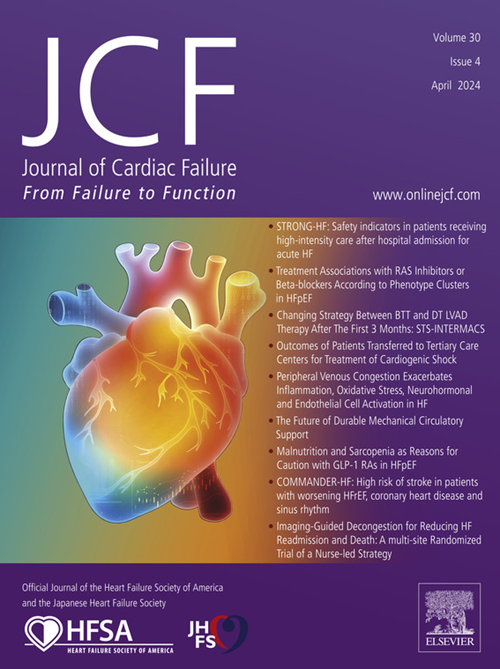可穿戴加速度计对心力衰竭患者体力活动的测量:DETERMINE 试验的启示。
IF 6.7
2区 医学
Q1 CARDIAC & CARDIOVASCULAR SYSTEMS
引用次数: 0
摘要
导言:可穿戴加速度计可在正常生活条件下对体力活动进行连续评估,可能有助于评估心力衰竭的治疗效果。我们探讨了加速度计测量的体力活动和 6 分钟步行距离与患者报告的 DETERMINE 试验参与者整个左心室射血分数范围的功能限制测量之间的关系:DETERMINE试验中的一部分患者在试验期间的3个时间点(筛选和随机化之间、第8周和第14周)佩戴了腰部加速计,为期7天。患者在基线、第 8 周和第 16 周填写堪萨斯城心肌病问卷 (KCCQ) 和 6 分钟步行距离 (6MWD):在随机抽取的 817 名患者中,319 人(39%)有足够的加速度计基线数据。体力活动水平较低的患者 KCCQ 评分和 6MWD 均较低(即较差),NT-proBNP 水平和 BMI 均较高,肾功能较差,糖尿病和心房颤动患者较多。基线加速度计值与 KCCQ 总分呈弱相关性(Pearson r=0.06 至 0.21),与 6MWD 呈弱至中等相关性(Pearson r=0.20 至 0.31)。加速度计测量的体力活动从基线到16周的变化与KCCQ总分(Pearson r=0至0.18)和6MWD(r=0.01至0.10)的变化呈弱相关:在 DETERMINE 试验中,基于加速度计的体力活动测量与 KCCQ 总分和 6MWD 的相关性不大。基于加速度计的体力活动评估可提供额外的信息,补充从心衰患者功能限制标准测量中获得的信息。本文章由计算机程序翻译,如有差异,请以英文原文为准。

Wearable Accelerometer-Derived Measures of Physical Activity in Heart Failure: Insights From the DETERMINE trials
Introduction
Wearable accelerometers allow continuous assessment of physical activity during normal living conditions and may be useful in evaluating the effects of treatment for heart failure. We explored the relationships between accelerometer measures of physical activity and 6-minute walk distance and patient-reported measures of functional limitation in participants across the entire spectrum of left ventricular ejection fraction in the DETERMINE (Dapagliflozin EffecT on ExeRcise capacity using a 6-MINutE walk test in patients with heart failure) trials.
Methods
A subgroup of patients in the DETERMINE trials wore a waist-based accelerometer during 7-day periods at 3 points during the trial: between screening and randomization and during weeks 8 and 14. Patients completed the Kansas City Cardiomyopathy Questionnaire (KCCQ) and 6-minute walk distance (6MWD) at baseline and at weeks 8 and 16.
Results
Of the 817 patients randomized, 319 (39%) had adequate baseline accelerometer data. Patients with lower levels of physical activity had lower (ie, worse) KCCQ scores and 6MWD, higher NT-proBNP levels and BMIs, worse kidney function, and a greater likelihood of diabetes and atrial fibrillation. Baseline accelerometer values had weak correlations with KCCQ summary scores (Pearson r = 0.06–0.21) and weak to moderate correlations with 6MWD (Pearson r = 0.20–0.31). The change from baseline to 16 weeks in accelerometer-measured physical activity correlated weakly with the change in KCCQ summary scores (Pearson r = 0–0.18) and 6MWD (r = 0.01–0.10).
Conclusions
In the DETERMINE trials, accelerometer-based measures of physical activity correlated modestly with KCCQ summary scores and 6MWD. Accelerometer-based assessments of physical activity may provide additional information complementing that obtained from standard measures of functional limitation in patients with heart failure.
求助全文
通过发布文献求助,成功后即可免费获取论文全文。
去求助
来源期刊

Journal of Cardiac Failure
医学-心血管系统
CiteScore
7.80
自引率
8.30%
发文量
653
审稿时长
21 days
期刊介绍:
Journal of Cardiac Failure publishes original, peer-reviewed communications of scientific excellence and review articles on clinical research, basic human studies, animal studies, and bench research with potential clinical applications to heart failure - pathogenesis, etiology, epidemiology, pathophysiological mechanisms, assessment, prevention, and treatment.
 求助内容:
求助内容: 应助结果提醒方式:
应助结果提醒方式:


